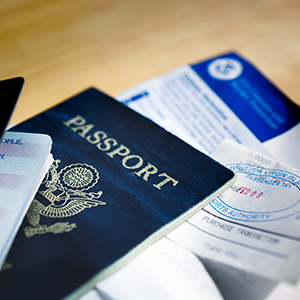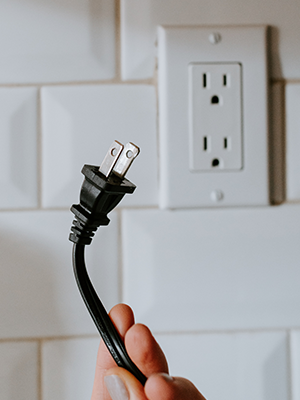What to Bring to Canada
 The list below is not exhaustive, and you should ensure that you make a list to compare to the information below before you travel.
The list below is not exhaustive, and you should ensure that you make a list to compare to the information below before you travel.
Note: It is important that you do not leave the airport or border until you have a Study Permit issued by an immigration officer. When you arrive at a Canadian port of entry such as the Toronto Pearson International Airport, you must present yourself to Canadian Immigration. You will be asked for documentation, such as the Letter of Introduction (given to you by the Canadian Visa Office when you applied for your Study Permit) and your letter of acceptance from Western. After the officer processes your information, they will give you a Study Permit (a piece of paper often stapled to your passport). When you get a chance, write down the expiry date of your Study Permit so that you will remember to renew it two to three months before it expires.
Essential Documents
- Valid passport
- OR proof of citizenship for U.S. citizens
- OR a valid green card and passport for U.S. permanent residents
- Valid Canadian Temporary Resident Visa or an eTA (Electronic Travel Authorization) (if applicable)
- Letter of Introduction issued by the Canadian Visa Office that approved your Study Permit application. Submit this letter to a Canadian Immigration Officer when you arrive at the border to obtain your actual Study Permit.
- OR a valid Study Permit if you have one
- Original Letter of Acceptance from Western University if you are entering Canada the first time
- OR if you studied online before entering Canada or you are re-entering Canada you will need a Verification of Enrolment letter. Request and download a PDF letter from the Office of the Registrar in Student Center.
- Proof of funds available for your stay in Canada (money transfer, letter of credit, scholarship/assistantship letter, or other proof)
- Marriage Certificate and/or proof of common-law status (if applicable)
- Any other documents recommended by the Canadian Visa Office when you applied for your Study Permit
Note: If you are a US Citizen/ Permanent Resident or a resident of Greenland or St. Pierre and Miquelon and are applying for a study permit at the border ensure you have all the required documents and the application form. A permanent resident of the US must also obtain an eTA in order to apply for a study permit at an air port of entry.
Carry all of the above documents with you when you travel to Canada and be prepared to show them to the Canadian Immigration officials at the Canadian Port of Entry (e.g., the airport). Do not pack these documents in your checked luggage. Make photocopies to leave with family or friends at home.
Other Important Documents
- A list of any items that you are sending separately or which you do not clear through customs when you arrive. Have the list stamped by immigration, if possible.
- Medical and Immunization (vaccination) Records, translated, if possible
- Medical Insurance Policy (if applicable)
- Driver’s license or International Driver’s license, driving insurance records, and Vehicle Registration and Insurance Papers if you plan to drive in Canada
- A list of important phone numbers
Declaring Personal Items: What NOT to Bring
Review current Canadian customs regulations before arriving to Canada.
Prepare a list of all the goods you are bringing into Canada (e.g., clothing, electronics, etc.) including vehicles. Be prepared to show your list to the Canada Border Services Agent at the Canadian Port of Entry. Make two copies of the list. If you have a vehicle, include its value, make, model and serial numbers. You can bring in other non-consumable goods (e.g., clothing, electronics, etc.) after your initial arrival, but you must report these goods to the Canada Border Services Agency. They will require a refundable deposit.
In general, restricted and prohibited goods fall into these major categories: firearms/weapons, food/plants/animals, explosives/fireworks/ammunition, cannabis/drugs, consumer products. Many of these are not permitted entry into Canada so it is important that you review what you can and can't bring and what you must declare when you cross the Canadian border. For more detailed information on which goods you can legally bring into Canada, refer to the 'Entering Canada to Study' section of the online brochure Visitors to Canada and Other Temporary Residents and the following resources provided by the Canada Border Services Agency:
Personal Items and Money
When you arrive in Canada, you should have access to at least enough money for your immediate needs (e.g., food and accommodation for your first week). We do not recommend carrying a large amount of cash, but having enough money for a few meals and/or a taxi ride will make your trip more comfortable. Here are some additional items to consider bringing with you from home:
- Clothing for the different seasons
- Something personal from home (music, pictures, books, movies, special food items, etc.) to help you feel comfortable as you settle in
- Medications you may need for the first few months
- Medical prescriptions
- A credit card
- Relevant documents from previous school (e.g. transcripts, awards, or any other certificates)
 Electronics and Chargers
Electronics and Chargers
Plugs like the one shown in the image in this section are used in Canada. The plug type that is shown with the double prongs is type A and the outlet shows type B. Both A and B plugs can be used in the outlets shown, and personal devices that don't have plugs like the one shown will require an adapter to use in Canada.
Depending on the voltage of your outlets at home, your electronics like chargers and personal appliances might not work as usual and may even get damaged. The household voltage in Canada is 120V but many countries have household voltages of 230V or 240V. You should confirm that your devices can be safely plugged in when you arrive in Canada by checking your household voltage. Many devices now are dual voltage, meaning that they will work the same in Canada. For a full explanation and a list of household voltages and plug types please review The Ultimate Electricity Guide for World Travellers. Here are some things you may need when packing for your trip:
- Mobile phone that can be used in Canada. This reduces the cost for your Canadian phone plan if you bring your own device.
- Travel adapter (if you aren't from Canada, USA, Japan or Mexico)
- Travel converter (if your household voltage IS NOT 120V)
- Charging cable for personal electronics such as cellphones, tablets, cameras, power banks, laptops, etc.


